IMDb meta-data is runtime of 1 hour and 9 minutes, rated at paltry 7.2 by 9211 cinemitizens. Released on 30 April 1943.
Genres: Horror, Drama
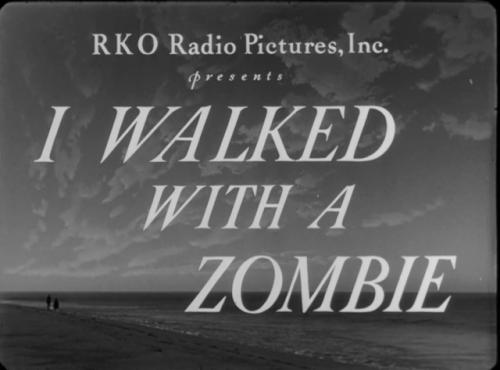
Verdict: Jane Eyre in the West Indies.
On a blustery day of snow and wind in frozen Ottawa a pert young nurse is offered a post on a tropical island at a good rate of pay, expressed in dollars.* Off Nurse goes to San Sebastien where she meets the half-brothers Smooth and Touchy. Her assignment is to look after Mrs Smooth. ‘An invalid?’ she asked. No….. She meets Mrs later that night as a hot wind stirs the palm trees and rustles the cane fields. Disturbed by the sound of crying, Nurse finds the sleepwalking Mrs in a spooky tower.
There is tension between the brothers and it seems to relate to Mrs. James Bell gives an Oscar-worthy performance as the local doctor who mediates between medical science and the voodoo gods. The ambiguity remains throughout.
Smooth says that his family is cursed by its history as slavers. He is as morose on this island paradise as a doomed, grey man in the Nordic ice fields written by Henrik Ibsen, bearing the sins of his fathers. While Touchy defers to Smooth as the elder brother and as manager of the cane plantation, he assiduously undermines him. (Reminds me of so many people I have worked with in that passive-aggressive mien.)
The slave past remains in the local culture. When a baby is born the blacks cry for the pain and grief of slavery it will endure. Death is a time to celebrate release from those pains.
There is one creepy segment in a sugar cane field at night.

This episode might be the most memorable in the film, especially the line, ‘She does not bleed.’
A number of blacks populate the scenes, mostly in the background. But the crooner has some very pointed lyrics, delivered twice. He is credited as Sir Lancelot, born Lancelot Victor Edward Pinard and raised in New York City. Theresa Harris lights up the screen as Alma, who knows far more than she says. She has more than a hundred films on the IMDb, often uncredited and inevitably as a maid. Darby Jones
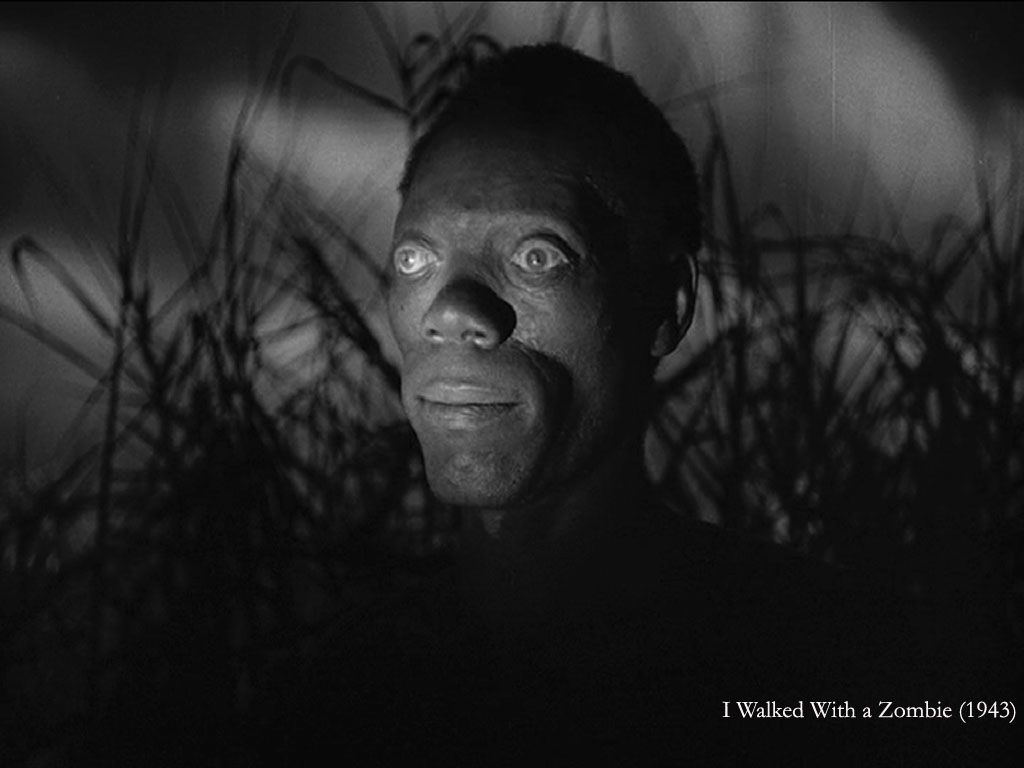
was cast for his bug eyes yet he remains dignified. He made a career out of jungle movies. The dancer who compels Mrs is the dynamic Jieno Moxzer. This is one of only two credits on the IMDb. Our loss.
None of the blacks is reduced to the comic stereotype so tiresomely common at the time in movies. That in itself is noteworthy. Added to that is the guilt of slavery articulated by Smooth, and it is a surprise package. Though there are some disparaging remarks in the script that irritated the fraternity brothers.
The screenplay is by Curt Siodmak, he of a long list of Sy Fy and Horror credits, and Ardel Wray. Some of the internet opinionators argue, well, assert, that the story is unusual for Siodmak. Not so sure myself. The air of menace, showing rather than telling, the concentric circle of stories are all motifs Siodmak used. But there is no doubt this one has emotional depth that may have come from Ardel Wray.

She, by the way, for refusing to rat people out was grey-listed during the Witch Hunts a few years later. Ergo her film credits are few. Grey-listing led her to work as a reader and editor in the back office at Warner Brothers. No longer getting screen credits kept her profile low.
After the debacle of Citizen Orson Wells at RKO, the studio was in dire financial straits. It was imperative to get revenue and there was little or no money. Val Lewton was appointed head of the B-Movie unit at RKO and he was handed a backlog of properties with deadlines for completing them. The KPI was $.
 Val Lewton
Val Lewton
Most of these properties were short stories, which had been purchased to get the titles, not the narrative, in the way that one today might purchase an internet domain to get the name, not the content. He then assigned titles to writers to produce screenplays quick-smart. Likewise he had to work with directors, technicians, and actors already on contract.
This film is one result. It was made on a micro-budget but with clever lighting, accomplished camera work, skilled editing, and brisk direction, it looks like an A-movie. Much of the credit for all the preceding qualities has to go to the director, Jacques Tourneur. His other credits include ‘Cat People’ (1942), ‘Leopard Man’ (1943), and ‘Out of the Past’ (1947). Winners all. He specialised in film noir. He, too, suffered from the Witch Hunts of the time, finding it opportune to return to his native France for extended vacations at times.
Though barely more than an hour long it is chocked full of characters and incidents, each carefully defined. Yet it does not seem rushed or crowded. It is another exhibit for a masterclass on film-making.
*One quibble though, it was only in 1949, per the fount of Wikipedia, that Canada introduced its dollar to replace the British pound.
Careful viewers will note that as the opening titles roll there is a disclaimer that ‘any similarity to any persons living, dead, or POSSESSED, is entirely coincidental.’ I put the capitals in for emphasis.
Category: Film Review
‘Murder in the Blue Room’ (1944)
IMDb meta-data is run time a snappy 1 hour and 1 minute, rated 6.2 by 151 cinemitizens.
Released on 1 December 1944.
Genre: Noir, Comedy.
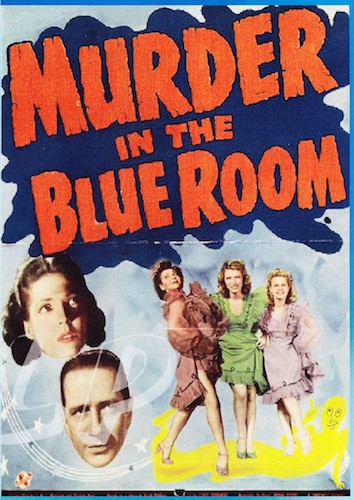
Verdict: All singing, all dancing gal pals do what has to be done.
To dispel superstitions about a mansion where a murder took place twenty years ago, the family puts on a party for family and friends. As the guests gather and cavort, the upstairs Blue Room, where the deed occurred is nonetheless kept locked.
Brash, a young suitor for Daughter, insists that he spend the night in the Blue Room to prove it is safe. This kNight errant hopes to win patronal favour for his matrimonial suit by this exploit. Sure, that is understood but safe from what?
Thereafter the plot thickens. The next morning, though the bell in the Blue Room rings for the butler, no one is there in the Blue Room when the ever typecast butler Edwards enters. Bernie OIds on loan from countless other cop shows, comes to investigate but makes no progress, apart from chewing on a toothpick. Brash has disappeared.
The sleuthing is taken over by the three Jazzy-belles on hand to entertain the guests. These wisecracking gal pals mix song with inference and dance with investigation. They are amusing. The music has zest. The dancing is Olympic standards. Very diverting. All so much better than say the Ritz Brothers, originally contracted for this film before they got a better offer.
Needless to say there is a villain, and it is a he, the one least suspicious. Of course.
For once Ian Wolfe as the eternal butler gets some good lines and moments on camera, and he makes the most of them.
The Jazzy-belles carry the picture, a scratch group assembled for this film, it seems: Grace McDonald, Betty Kean, and June Preisser. Two of them had short careers but McDonald continued in television into the 1980s.

A rarity then for the time with these three as the principal players.
The screenplay confused the fraternity brothers. At one point, speaking of the death in the Blue Room, a member of the family says no one knows how the victim, her father, died. Later her brother says their father was shot. In both cases the attending physician is present along with several others. Throughout there is friendly ghost in attendance who is not integrated into the story but is there for comic irritation.
As this film made it way across the country, the newsreels that preceded it would have carried the news of the enormous and ominous reverses Allied Armies began to suffer in the Battle of Bulge.
‘The Amazing Mr X,’ aka as ‘The Spiritualist’ (1948)
IMDb meta-data is runtime a brisk 1 hour and 18 minutes, rated at 6.5 by 1155 cinemitizens.
Genre: Noir, Mystery
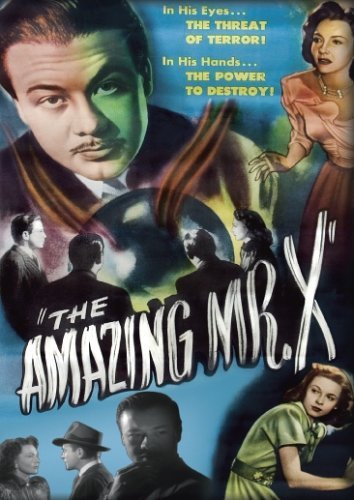

Verdict: Noir at its best.
Babe is a two-year widow who starts hearing his dead husband’s voice in the air without a BlueTooth headset. Oh Oh. This irritates Richard Carlson, her new suitor. She has an Ingenue sister who lives with her in a mansion on a cliff top. Where else?
Walking on the beach below one night, she encounters Mr X, who tells her about herself for he is a medium and sensitive to her vibrations. [There were snickers from the fraternity bothers at his point.] The Viennese Mr X oils his way into her life.
He is an utter cynic, having planted an accomplice as a maid in the mansion to glean information. His aim is to separate this widow from a lot of moolah. Ingenue falls in love with him and his oily ways. Widow is perplexed by it all.
A séance is arranged in Oily’s wired up studio. The party is crashed by Carlson and the private dick he has employed. The crashers insist that the show go on; Oily tries to grease his way out of it to no avail. His hand is forced and the lights go down. Then….
The dead husband appears to all. No one is more amazed than the amazing Mr X in a star turn.
Seems husband has had several widows pining for him and he has plans to reduce the number. The plot twists even more, and Oily discovers, to his own surprise, that there are some things he will not do for money. Ingenue figures it all out and ….
It is a master class in creating an atmosphere heavy with mystery and peopling it with rounded characters yet including all the clichés, to wit, a crystal ball, a turban, and a raven. All in just over one hour of runtime.
The dead husband is menacing and ruthless. The private dick has a sense of humour. Carlson is so earnest that he made the fraternity brothers feel guilty. Ingenue is so enthusiastic it is hard to take. Babe is so perplexed that she must have been reading some of Martin Heidegger hieroglyphs.
But the real star of the show is the camera, and the lighting that emphasises the air of mystery and confusion. Harvard graduate Bernard Vorhaus directed. He is another victim whose career was blighted by the HUAC, the monster that roamed Hollywood off camera for far too long. He gave David Lean his first job in movies. After being black listed Vorhaus went to England with his Welsh wife and changed careers, working on home renovations. Our loss.
‘The Incredible Petrified World’ (1959)
IMDb meta-data is Dali time of 1 hour and 10 minutes, rated a generous 3.0 by 837 cinemitizens.
Genre: Sy Fy, Horror, Boredom
Verdict: Incredible alright.
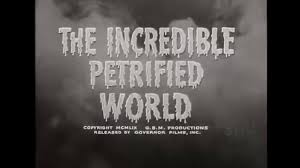
Here is the deal. John Carradine wants to touch the bottom of his career and so manufactures a diving bell and sends four nitwits to the bottom in it, two of each. That sounds a lot better than it is.
The first ten minutes is stock footage of the ocean. Thereafter the characters line up against a semi-circular wall and talk. Sometimes the wall is supposed to be in the mansion sized diving bell, sometimes in a Titanic ballroom on the tugboat transporting the bell, sometimes in Carradine’s California Marine Institute arena, and sometimes in the Golden Caves of Arizona.
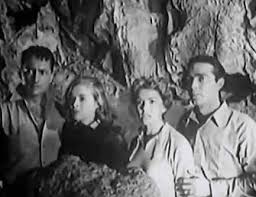 Now, no one move!
Now, no one move!
Once aligned no one moves so that the focus does not have to be pulled again.
Is it Post-Modern? It does not privilege intelligence or interest over static and boring.
The four descend and get stranded, but that is all right because they find submarine caves rich in oxygen. Forty minutes of stumbling around and they encounter Santa Claus whose sleigh went down over water. He says he got there the same way they did. Evidently he acted in an earlier Jerry Warren movie. Poor guy.
They stand and talk, talk and stand, and, for a change of pace, stand and talk. Then thanks to a cut away, they are rescued by the second diving bell Carradine had up his sleeve.
Never have the words ‘The End’ been so welcome.
There is no tension. That two nubile women and two virile men are about to die in the caves, produces nothing but boredom in them and in us.
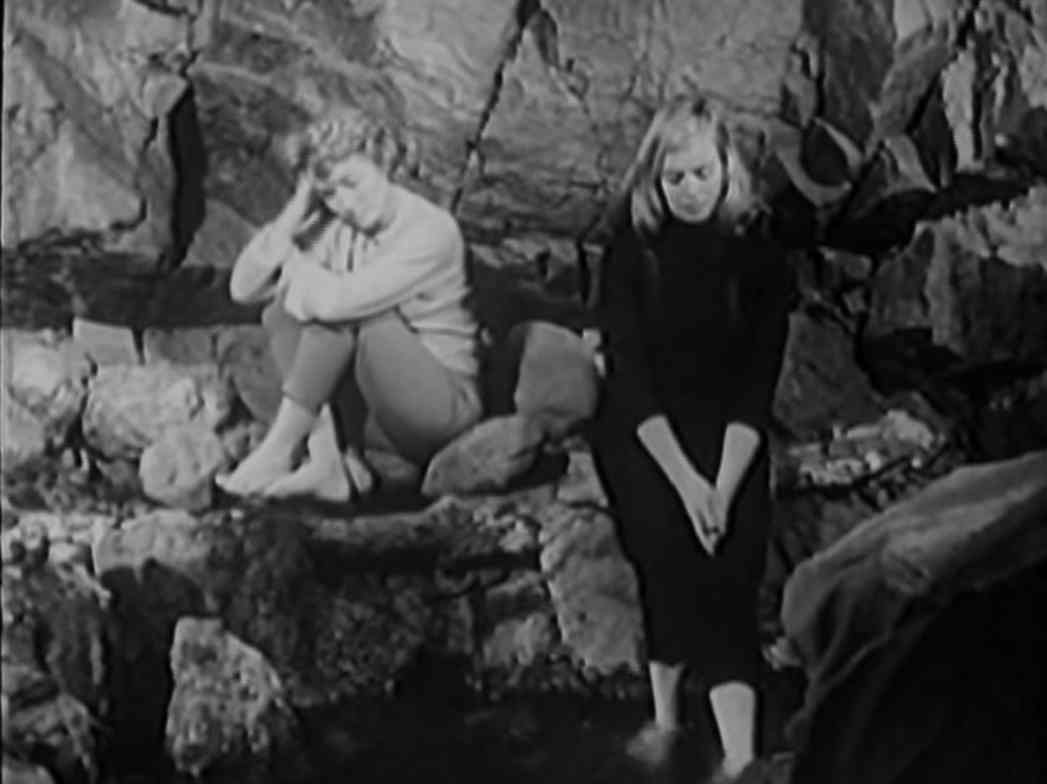 They read the script.
They read the script.
That the bearded Santa spies on them and has strange ways, leads to nothing. That they are rescued is done off-camera so there are no heroics there. Indeed the only mystery is why Robert Clarke keeps taking his shirt off and putting it back on again. The fraternity brothers counted three times, but they may have missed one when the beer keg popped.
Carradine is as always Carradine of the compelling mien and voice, but there is nothing for him to do and he does it — nothing. Lois Lane is there with even less to do. For the rest of the cast, this is their ‘Best Known For’ entry on the IMDb.
Written, produced, and directed by Jerry Warren who enjoys the reputation on IMDb as the auteur of cheap and ridiculous horror movie quickies. His CV includes ‘The World of Bat Woman,’ ‘Teenage Zombies,’ and ‘Terror of the Blood Hunters,’ each of which orbits a rating of 3, as does the waste of space at hand.
It was finished in 1957 but not even the Lippart Brothers would distribute it so it languished for two years before being paired with another turkey and released for the Drive In market confident no one would see it.
The fraternity brothers thought petrification happened to them while watching this drab and pointless use of celluloid.
‘The Man Who Wouldn’t Die’ (1942)
IMDb meta-data is runtime 1 hour and 5 minutes, rated 6.7 by 336 cinemitizens.
Genre: Noir, Horror, Comedy.
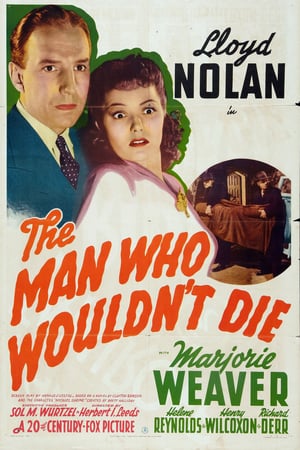
Verdict: Spooky and snappy.
It was a dark and stormy night as moody, muddy, and misty camera angles play over the dark mansion when a gun shot is heard from within. The front door of the mansion opens and three men emerge from it hefting a bundle into the trunk of a car and drive off. Through the wind and lightning the camera follows. They extract a deadman from the trunk and bury him on the vast grounds of the estate, while in the bushes they are silently observed by a solidarity and soggy onlooker. Whew! All of this before a word is spoken.
While this is going on, excited Daughter returns to the mansion to announce her wedding, finding her step-mother distracted, as her damp father and his two retainers return from their secret nocturnal errand. Bubbling though she is, Daughter realises something is amiss, the more so later when a spectral figure fires a gun at her while she lies abed. In the subsequent fuss, Father, Step-Mother, and retainers deny a shot was fired, while casting side-long glances at each other.
Despite being treated like an hysterical child, Daughter knows what she saw, and off-camera she places a secret phone call to the 4F Michael Shayne. Who else!
There is fine cinematography of the old dark house, the constant rain with thunder and lightning, and most of all the spooky and spectral figure who keeps reappearing in the night, he of the title.

There is much to’ing and fro’ing, mistaken identities, a bemused butler, a befuddled lawman, an intrigued undertaker, a pompous father, a scheming step-mother, a strange laboratory in the basement, plotting retainers, all in all it is a veritable school of red herrings in which Shayne fishes.
This is an entry in the Michael Shayne series started in 1940, starring Lloyd Nolan as the eponym.
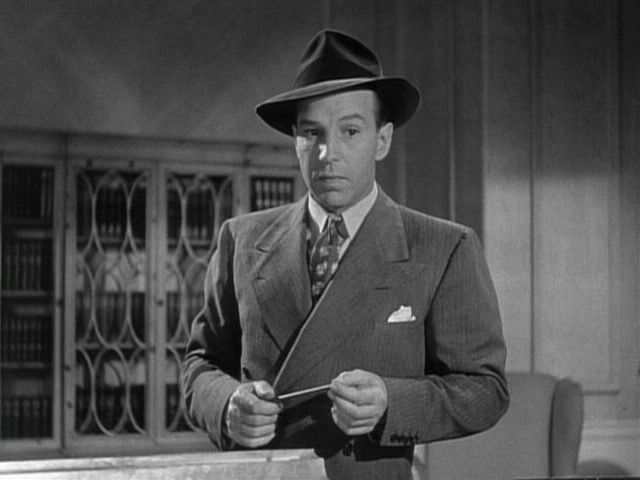
He made a career out of playing the New York City Irishman, following in Pat O’Brien’s footsteps, though he was born and reared in San Francisco, attending Stanford University until catching the acting bug. He spent virtually no time in NYC, least of all Flatbush and Brooklyn, except for location filming. While his Irishisms are gratuitous in this film, he delivers them with an effortless panache. He is described as ‘an actor’s actor,’ whatever that means.
The excellent screen play was by Arnaud d’Usseau, California born, but who took this name for caché, says inter-web gossip. He was later black-listed thanks to the efforts of Elia Kazan, which brought d’Usseau’s career to a premature end.
Released on 1 May 1942, within a week Corregidor surrendered and 12,000 GIs became POWs to join a like number captured on Bataan. You would never know the war was on watching this film, which perhaps was the aspiration of the filmmakers, because none of the news at the time was good and it got worse. As the film travelled the country the news reels preceding would have covered Corregidor. The Bataan Death March was censored until 1944.
‘The Earth Dies Screaming’ (1964)
IMDb runtime an eternity of 1 hour and 2 minutes, over-rated a generous 6.0 by 1147.
Genre: Sy Fy
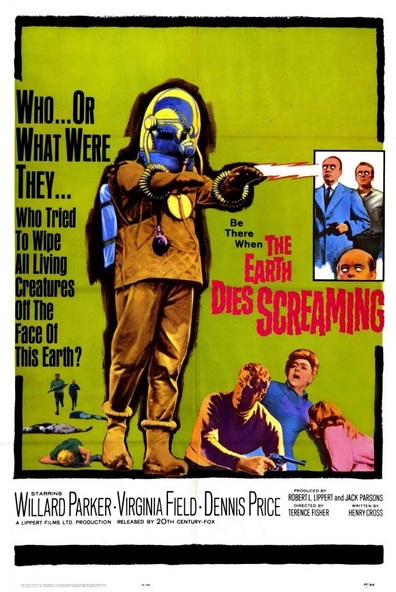 The earth does not scream.
The earth does not scream.
Verdict: A quota quickie in every way but fact.
The set-up is a nice opening with a British Rail train, late as usual, ploughing off a bridge because the engineer is dead at the controls. (Union rules mean a dead driver cannot be fired.) Then an airplane does the same with a dead pilot at the controls. (Same union rule.) A bowler-hatted gentleman at a train station, who failed to notice the dead bodies littering the platform, keels over. There follows pan shots of village streets with folks who fell dead in their tracks, the newspaper delivery boy, a lady shopper at a green grocer, a bus driver, and so on.
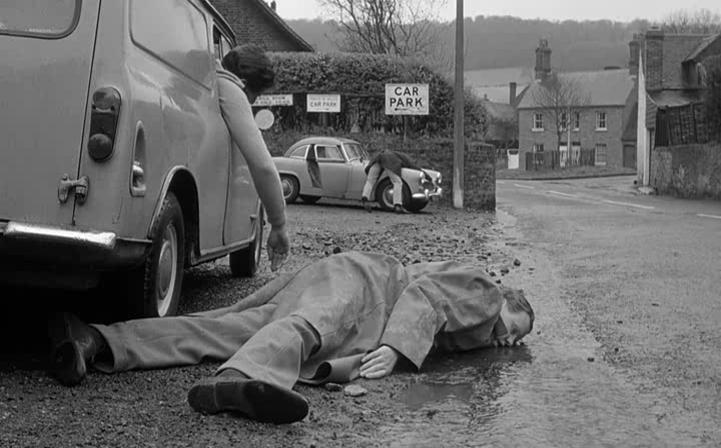
This is nice and there is no sound to distract. The silence makes it more ominous.
Into such a village of the dead drives Worster in a Land Rover, as he exits the vehicle he takes out an Enfield rifle. Whoa. He helps himself to food at a shop and then a drink in a pub, stepping over and around the littered bodies. As he sips in the pub he is accosted by Dennis Price, whom I could not take seriously as a villain, but villain he is. For a start he is in the company of a lady who is not his wife, but whom he introduces as his wife, and we know she is someone else’s wife! Go figure. On this subject there is more tittle-tattle to follow. Read on.
Later they are joined by a young couple. Thus we have gathered in the village of Otranto the crew. Worster is an American among the Brits. Ok. He claims to be a test pilot with the Vertical Take Off and Landing project, the Harrier Jump Jet as it was later called. That was a nice topical reference, but, hey, Worster is forty-nine (49, for those who cannot read words) and long in the tooth and grey in the hair, and large of the waistline for a flyboy and it shows in his leaden movements. Then we have Dennis without menace. His companion is Old Virginie, and she is forty-five. They are joined by a couple in their late twenties. Thorley Walters and his companion are also there to add the buffoon touch to the gathering.
They make an uneasy alliance and try to infer what has happened. The conclusion is that there was a gas attack and those, like themselves who survived, were sealed up somewhere, the pilot in an airplane, the villain and his moll is sealed room, and so…(I forget what the others said). (This quarantine also figures in the superior ‘The Night of the Comet’ (1984) reviewed elsewhere on this blog.) The gas has now dissipated.
Ah ha! The pilot was in a plane, but one of those was shown in the lead-in…and he was dead at the controls. How come Worster did not cack it, too, chimed the fraternity brothers. Dunno.
The young woman is pregnant and Old Virginie is assigned to look after her because she is a woman and women know about such things. To her credit she denies such knowledge, but the chaps disregard this is the best style of the times. While they are drinking themselves into oblivion in the pub they see strange figures in the streets. The requisite hysterical woman in their number rushes out, and has to run after and after, in her six inch high heels, the Reynolds Wrapped creatures, who are oblivious to her until she grabs one. It is a nice moment when it turns and reveals itself to be … a Republican Congressman and zaps her.
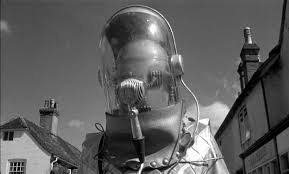
Another Brexit voter exits.
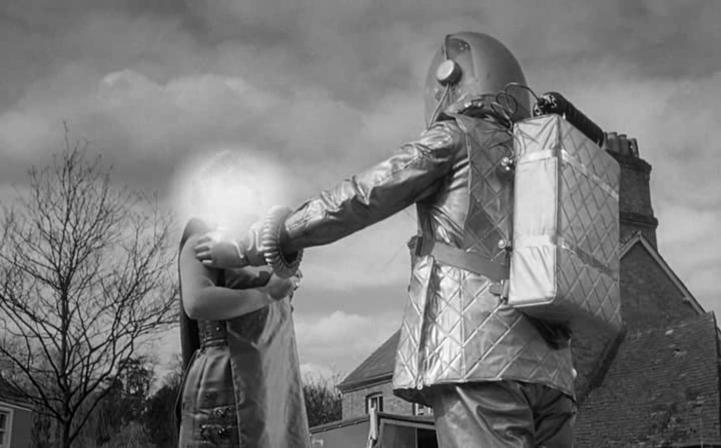
Zap! The others observe this zapology from a distance.
Later in a twist some of the dead rise as white-eyed zombies and there is one nice moment of tension when Old Virginie hides in a wardrobe from one such zombie. Being dead, they have an excuse for their leaden motions. Along the way Thorley also gets zapped, or did he. Can’t remember. Dennis without menace is offed. That leaves the young and old couples, plus the newborn baby.
Later these Reynolds Wrappers move like lead, even slower than Worster, and seem to be deaf, dumb, and blind as well as Republican. If their mission is to finish off the survivors of the gas attack in a search and destroy mission they have failed the KPIs miserably. It turns out they are robots controlled by radio transmission from a conveniently located tower which Worster blows up (because as a test pilot he is also a demolition expert) and that frees the local area of this scourge. Whew!
What next? They will find a plane and fly around to attract the attention of other survivors. Huh? Won’t that attract the attention of other Reynolds Wrappers, too? And the plane we see take off is a four engined Constellation that needs a long hard runway. It will not bob down to pick a few folk standing around an SOS sign.
The end.
Worster and Old Virginie (she being Brit) were married in 1951, more than a decade before they teamed up in this outing and they stayed married until her death in 1992.
It was not a quota quickie, as explained elsewhere on this blog, but it has some of the qualities in the cheap production and gratuitous insertion of an American actor from the C-list, and it was distributed by Lippart, a well-known bottom feeder. The chatter on the inter-web is that Old Virginie went back to England for family reasons and Worster came along and they did this film to pay for the trip.
It fits the Brit practice of Sy Fy in rural settings. Long before Midsomer Murders the English countryside was a strange place where strange thing happened to the strange people who are there. It was also cheaper to film that.
‘It Happens Every Spring’ (1949)
IMDb meta-data runtime is 1 hour and 27 minutes, rated way too high 7.0 by 1401 cinemitizens.
Genre: Sports, Comedy, Romance, Sy Fy, Nothing
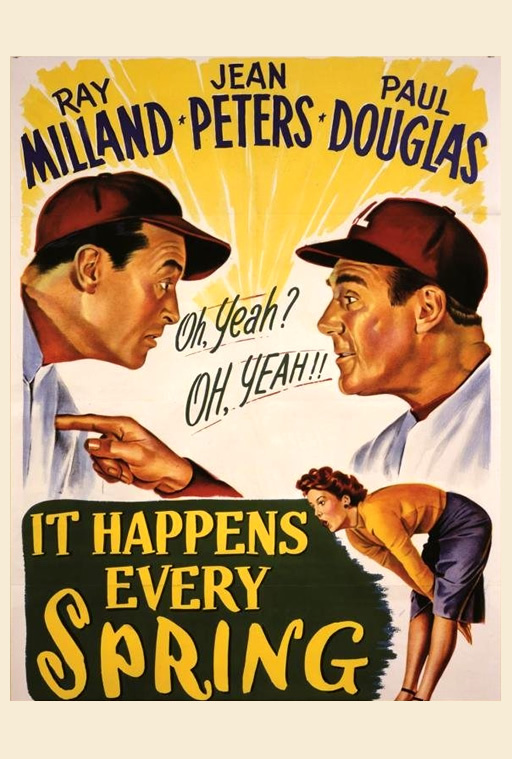
Verdict: Odd and off.
The set-up is this. Ray is a college chemistry professor engaged to the dean’s daughter, working on a consultancy to treat timber to repel pests, borers, fraternity brothers, insects, boors, and any and all of the above. This job will win the dean’s approval by bringing much needed funding to the college and so his consent for the hand and what is connected to it of his daughter.
Into this neat plan intrudes a baseball, hit through a window in the Chem Lab, that obliterates the project, including note books, etc. Depressed, Ray cleans up and notices that the baseball, which got soaked in a solution, is now repelled by wood. It just so happens that Ray is a baseball fan of the First Water and decides this is the way to fortune. He will become a baseball pitcher no one can hit, make dosh, marry daughter …. the end.
While the supporting players were dandy, including the very young skipper from ‘The Minnow,’ the story left me cold. Very cold. There were two reasons, one odd and the other off.
The odd one first to get it out of the way is this. When Ray got on the team in St Louis everyone refers to him as the Kid. He becomes Kid Kelly. Right. A 44 year-old kid, making him older than any other player on the St Louis rosters the time time. Yes, I checked for both the Browns and the Cardinals. Some kid. By the way, Ray was 44 and his romantic interest, Jean Peters was 23 at the time. Make of that what one will.
 The 44 year-old kid.
The 44 year-old kid.
The off irritant is that Ray’s secret was ball tampering. Such ball tampering as Ray gets up to when he rubs the solution on the baseball was outlawed in 1920. End. Illegal. This dead obvious fact any baseball fan in the theatre would know is never broached, skirted, or implied. Huh?
That ball-tampering solution is what gets it a Sy Fy tick.
A slight redemption occurs at the end when Ray notes he made more money in one baseball game than a year of teaching chemistry. Think about that today when athletes make more money individually than entire colleges faculties put together and then tripled.
Ray seems hopelessly inept pretending to be a baseball player. Clearly, like Gary Cooper as Lou Gehrig, he had never played baseball in his youth. Yet Ray at least had been as sportsman in his native Wales, and become a member of the Household Cavalry in 1928. That is indicative of his horsemanship. The Great Depression ruined his family and he took to acting for a crust. It seems he slept his way into pictures. He wore a toupee from his mid-thirties and so would have sported it in this picture.
Jean Peters sparkles in this small role but she quit when she married Howard Hughes and disappeared into Santa Monica hills seldom to be seen again. Though the ever reliable Wikipedia has it that the hilltop life was boring and under aliases she did one or more degrees at UCLA.
But the best performance in this movie, and in most others he graced, comes from Paul Douglas whose blue collar approach seems so fresh and direct compared to the ever twitchy Milland. Blue collar Douglas came to affect, but he was born to a wealthy Philadelphia surgeon who sent him to Yale where Paul rebelled, as sons do, and instead played semi-professional football. That led to sports journalism, newspapers and then radio. He liked an audience and soon dabbled in amateur theatrics…and made his way to Hollywood. Many of his films involved sports, like the whimsical and much redone ‘Angels in the Outfield’ (1951).
My glance fell on some of the reviews linked to the IMDb entry and I am moved to remark again on the human condition. One opinionated reviewer huffed and puffed about the film, and was particularly critical of the title because it is never explained. That reviewer needs to get out from under the rock more often. What happens every spring? Even the fraternity bothers know that. Well, two things. One it is the mating season and hence Ray’s round-about courtship of daughter. More importantly here, the baseball season starts!
‘Revenge of the Zombies’ (1943)
IMDb meta-data is runtime 1 hour and 1 minutes, rated 4.6 by 510 cinemitizens.
Genre: Horror
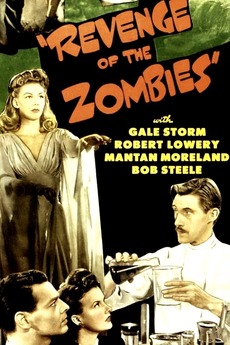
Verdict: Only for completists.
Set-up. Veda is dead. (What a waste since she is usually a corker.) But then John Carradine is her husband so maybe that explains her preference. He is Dr Max Heinrich von Altermann. Get it? Look at the release date, 17 September 1943. Max and Veda live in foggy Louisiana on the German Coast.
Veda’s brother, Stupid, comes to mourn her and vents his suspicious on anyone with a German name. He brings along Handsome. Neither one of these dorks can drive a car or carry a bag so they have Black Stereotype to look after them. There they find Gale Storm straight from secretarial school typing away, oblivious to everything.
Turns out Max has seen ‘Revolt of the Zombies’ (1931) and ‘King of the Zombies’ (1941) and mashed them together. From ‘Revolt of the Zombies’ he got the idea of an invulnerable (and cheap) army of the living dead and from ‘King of the Zombies’ he got a Germanic mad scientists to unleash such an army on YankeeLand, well, in this case DixieLand. Is that creative thinking, or what? Hmmm
So diabolical is Max that he is experimenting on Mrs Veda in life and in death. The fraternity brothers thought the worst. For them situation normal.
Now Stupid, Handsome, and Stereotype arrive to gum up the works. Stereotype realises almost instantly some creepy things are happening but when he tries to tell Stupid and Handsome they dismiss his reports as the hysteria, foolishness, and ignorance of a black man. The duty of being the butt for the arrogance of superior white men to kick often went to women.
Mantan Moreland
Stereotype investigates and finds out more and more but his information is rejected, ignored, and disregarded even while Stupid and Handsome investigate matters by smoking cigarettes. In this case it is very like, though no doubt unintended, ‘King of Zombies’ where the same black stereotype was far ahead of his white, superior masters.
Bob Steele is there, he of distinctive voice and mien that made him a delightful villain in Westerns, here partly in parody of that sort of role, as a double and triple secret agent to paper over the script holes.
Also in the cast are Uncle Remus and Madame Sul-Te-Wan who played maids, slaves, and natives in countless Hollywoodisms, going back to W. D. Griffith’s ‘The Birth of a Nation’ (1915) and ‘Intolerance’ (1916) and including ‘King Kong’ (1933).
Mantan Moreland has 130 credits on the IMDb. He and other black actors of the era were later reviled for embodying stereotypes as noted above. Madame Sul-Te-Wan said, her choice was to work as a maid and earn $7 a day or to play a maid in a movie and earn $70 a day. She found it an easy choice.
Even at 61 minutes, it seems padded. Carradine sleep walks through this one without any of the intensity and malevolence he could muster. There is not much Veda can do as a corpse,
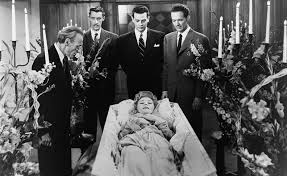
though she tries. The only energy comes from Stereotype. There are a couple of good one-liners but the fraternity bothers were dozing when they came. The ending in the swamp is neat but leaden in execution.
‘Riders to the Stars’ (1954)
IMDb meta-data is runtime is 1 hour and 21 minutes, rated 5.5 by 535 cinemitizens
Genre: Sy Fy
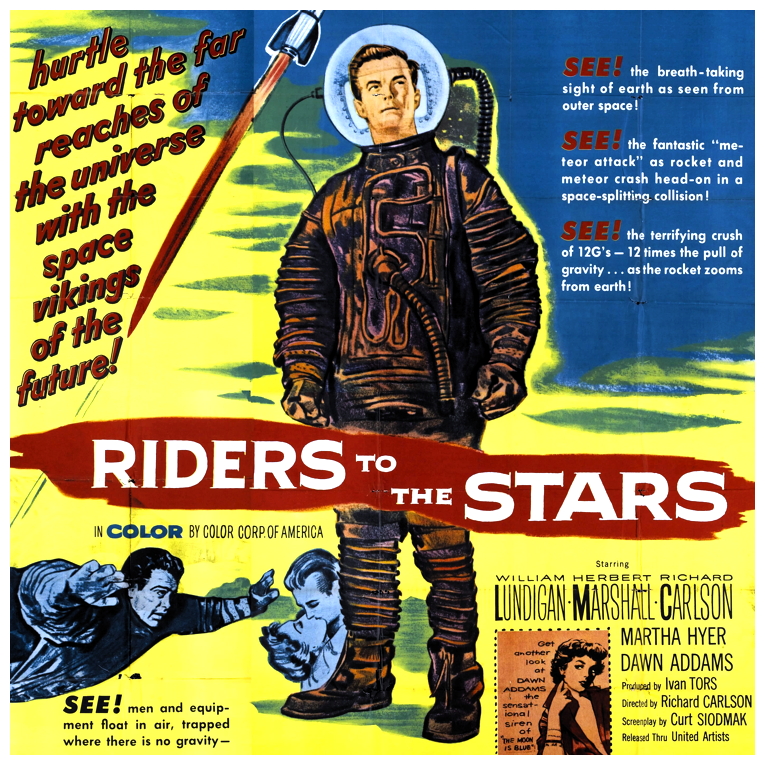
Verdict: Stolid.
Setup? Things are going badly for the US rocket program, despite the best efforts of Herbert von Marshall. The rocket go up whole and then come down in pieces. (That was true, about sixty in all.) What is happening? What is to be done? Herbie V ponders these questions behind his owlish glasses with his team in the heart of the darkest California desert.
Then Ice Blonde concludes the rockets have to be shielded from the cosmic rays that are disintegrating the hulls. ‘Ah ha,’ mutters Herbert, ‘Yes, we have to do this before THEY do.’ This would be the Red THEY of the Coldest War.
Now the talk shifts to what kind of shield? Meteors rocket around without disintegrating until they burn in the Earth’s atmosphere. They must have a protective coating in space which is lost when entering the atmosphere. What we need is a meteor from space so we can examine its protective coating of carbonised bumpkin. Well, why not, the meteor shower is in every Sy Fy scriptwriter’s play-book. (Of course, this line of reasoning makes no sense since the rockets will have to pass through Earth’s atmosphere twice. If the atmosphere strips the coating off a meteor on entry, it will have two chance to do that to a rocket.)
Rockets they have aplenty from the bottomless budget allocated to get ahead of THEY. Mission they have, lassoing some meteors in the wild. Now they need some rocket boys to sit atop of tons of volatile liquid nitrogen that can go bang at the spark of a split infinitive. Herbie has been sending white mice — discrimination against brown mice? — up in rockets to study weightlessness but he is pretty sure the Aryan mice are not up to meteor-grabbing. Why not use a computer? Because in 1954 a computer was a mile long and weighted more than a Hollywood actor’s ego. Ok, it has got to be people, well, as of the times, men.
And not just any men but a carefully selected set of Hollywood supporting actors who are chosen by the whirring of computers scanning punch cards. (Be glad if you don’t know what a computer punch card is.) About twenty supporting actors and the leads are invited to join a secret project. Some say ‘Buzz, off.’ Others rush to the door to escape the unwanted consequences of a wanted act. Others go as relief from the boredom of life on civie street. Because it is a curious offer. Because it must be important. Because it is on the way to the pay office. Because the alternative is another McKinsey training seminar. And finally because the script says so.
The twelve who said ‘Yes’ arrive, all wearing neck ties and business suits and about half wear hats. Several smoke pipes and more than half of the others are sucking cigarettes. Is it any wonder lung cancer surgeons look back on the old days with nostalgia.
Next comes the rigorous testing for the mission. It is in two parts, the first psychological and the second physical. The psych test is fiendish. They are seated in a meeting room and told that the training session will begin shortly! There is no escape; the door is locked! And they wait. For hours. Hours. Hours. What to do? Light up. Everyone smokes. To some perhaps lung cancer was preferable to enduring yet another training session given by twenty-year olds who never use the system and have no corporate knowledge or interest.
James Best goes all whiny and storms around. Another one paces a hole in the floor. A third smokes three times faster than anyone else and disappears behind a midden of cigarette butts. A fourth goes all WTF and pounds on the door. While others sit calmly waiting, napping, talking about sports, or thinking about that Ice Blonde, as were the fraternity brothers.
Sorted. Whiny James (who is he best whiner in the business) is out. Ditto both Pacer and Pounder. Smoker though seems normal enough once he is disinterred from the ashes. How he is going to smoke in space is one of the imponderables that does not get pondered.
Next comes the needles to start the physical examination. Sight of the needle sends others packing. Then they go to the fairground and ride around to test stamina. Next comes the equipment training and more are winnowed out until only four are left. Then for reasons the fraternity brothers missed another one leaves. Some testing! They started with 150 million people and got down to three.
The rockets have scoops which were later passed on to Hugo Drax. But for now our trio go meteor hunting in the heart of darkest outer space. Whew. One bites off more than his scoop can chew and blows up. His skeletal face in a pressure suit floats by the window of a second scooper who panics and tries to bail out. So much for the rigorous testing program. Sight of the first stiff and he wants to bail, scoffed the fraternity brothers, while cowering behind the sofa in fright. Only the stolid William Lundigan prevails and returns to save US from THEY! That melts Icy.
This the third of Ivan Tors’s trilogy about the Office of Scientific Investigation, and as usual Tors tried to get some science into the story. Wacky though it is.
 Ivan Tors. Note the microscope. [Witticism needed for caption.]
Ivan Tors. Note the microscope. [Witticism needed for caption.]
Ergo the computers look like computers of the day and not Christmas toys. That is bland with nary an array of blinking lights to keep the audience awake. There are no voltmeters, retorts, or Tesla coils passing as advanced scientific equipment. The stock footage of rocket launches is well integrated into the props and effects. The pressure suits the flyboys wear are the real thing. The term ‘astronaut’ is not used.
There are no villains except for the off stage THEY. Space flight is hard enough without villains or papier-mâché spiders. Overcoming the laws of physics like gravity takes all the ingenuity there is. I certainly feel that way many a morning.
The fairground ride was in fact a centrifuge at USC which Tors got permission to use.
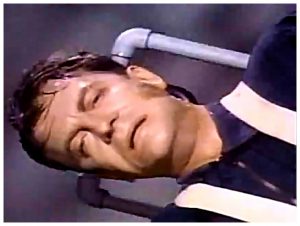 Lundigan getting G-forced for real.
Lundigan getting G-forced for real.
Some of the other effects are not as good. The wires in the weightless scenes are visible.
While all the potential fliers are men, the Ice Blonde comes up with the core idea, and she is a mathematician not a coffee-maker. Like everyone else in the script she is a Doctor and the title is uttered at least fifty times by one character or another about or to another. Fifty at least, because the fraternity brother who was counting ran out of fingers (don’t ask) at that point. Of course, Icy is there to pair off with Stolid Bill though how he could melt her is a tribute the the screen writer’s imagination. By the way the writer is the redoubtable Sy Fyian Curt Siodmak. All hail!
Speaking of Bill, well, it is hard to speak of him, because he is soooo bland. But there is a light in his eyes that sets him apart from the catatonic John Agar whose existential being was eroded by the hundreds of terrible parts he played until there was nothing left beneath. Bill is just attractive enough to be noticed by women but not so damn handsome as to irritate men. That middle way would seem to be his major attribute. He is calm, reassuring, steady, and stolid, and he had that mellifluous voice that got him started in radio advertising when his football career ended.
Having been a BMOC at Syracuse University he had a knee injury that made him 4F in 1941 but he volunteered anyway and in time served. That he volunteered voided his film contract and his career never quite recovered from that. Was he brown-listed? Did such tacky things happen in Tinsel Town? Most of his post-war career was in television. He was the one constant in the very realistic series ‘Men into Space’ (1959-1960) over thirty-eight episodes.
Richard Carlson of much Sy Fy fame is there as second lead and he got the directing credit in a deal with the producer Tors, though this is much discussed in the Cine Nerd Cyberdom. He is another Mr Ordinary, but with an intellectual and reflective mien that served him well. He had hoped to go into directing and this was his first outing, which was made difficult by playing in it as well, but it was a chance to try and he took it. He directed television episodes in the 1950s and 1960s including one starring Bill in ‘Men into Space.’
Hidden in the Ice Blonde’s one hundred and six credits on the IMDb is one star turn in ‘Some Came Running’ (1958), where she had more to do than be eye-candy. She is by the way Martha Hyer whose voice alone melted four of the fraternity brothers. Here she is endowed with sense, poise, intelligence, and purpose. Later she had the screaming, tripping, and fainting duty in ‘First Men in the Moon’ (1964) usually allowed to women in Sy Fy of the era.
Herbert Marshall was owlish in ‘Gog’ (1954), reviewed elsewhere on this blog. After having a leg amputated in Great War, he gave up a career as an accountant and took to acting. His first and most sustained act was to develop a walk that concealed his prothesis so well most did not know he had it. Ivan Tors thought his walk, which he had noticed, was an affectation for the role, only to be astonished later to see the wooden leg. That wood was a constant source of pain which Herbie doused with whiskey at all hours of the day and night without slurring or forgetting his lines. Thus did the show go on.
‘Another Earth’ (2011)
IMDb meta-data is runtime is 1 hour and 32 minutes, under-rated at 7.0 by 82,620
Genre: Sy Fy and empathy.

Verdict: Recommended for adults.
An intense tale of hubris, tragedy, and redemption with a blinder at the end.
It charts the budding relationship between a distraught man and the guilt-ridden girl, he nearly psychotic and she certainly neurotic, each with good reason.
What’s to like? (In no particular order.)
– the living Jupiter in the opening sequence.
– the video boxing.
– the essay about the losers being the people who go first.
– the other earth hanging in the sky ever an invitation to think twice.
– the chance meeting with a one-time high school classmate at the convenience store and his incomprehension that she is a janitor and her directness in saying so.
– the working class side of New Haven in the fall and winter as a setting: Barren, foggy, hard, bleak…. Yet the spring will come.
– the saw concert for one.
– that there was no resolution at the end just more questions.
And I really liked the very end. It was quite unexpected and yet dead obvious, both at once. If only…..
Cryptic and enigmatic at times, but it assumes an audience of adults who will not implode if everything is not rammed home with shouting, primary colours, and capital letters, an audience of adults who might later think about what they have seen in this empathy machine. The air of mystery that hangs over the film adds to its forlorn appeal. For example, what are we to make of the elderly janitor? His suicide attempt makes no sense and does not relate to either the major theme (the other Earth that is within us all) or the minor theme (the relationship of the wounded man and broken girl).
The rough edges show in some of the photography and camera work. Please use a tripod in the future.
The idea of another Earth figures in ‘The Journey to the Far side of the Sun’ (1969), reviewed elsewhere on this blog. But there is no other point of comparison between the two movies.
I cannot recall what prompted me when I bought on iTunes except that it was Sy Fy just before leaving for Honolulu in August 2012, and watched on the unendurable (see next paragraph) flight to Honolulu on my own before I went on to Omaha. Loved it. Put an edited version of these notes on IMDB and read Roger Ebert’s laudatory review. I posted a review on the IMDb but forgot to put it on the blog, until now when I went looking for it.
This flight to Honolulu promised to be unforgettable because my Economy seat mate wanted to tell me his sad life story at full volume even before seatbelts were fastened to make me a captive audience. Ten hours of that might have been fatal for one of us. But immediately after take-off a cabin steward said I could [hint, should] move to an empty row up ahead. There is a god. I did so, though even at that remove I could still hear my former seat-mate going on about his woes to those sitting behind him, and they encouraged him to go on, and on, and on, and he was still at it when those ten hours later we stood at the baggage carousel in Hono. Why this cabin steward picked me is the miracle in this story.
I read some of the one-star reviews on the IMDb. What a world! Lifeforms below Republicans exist. Who would have thought that was possible.
